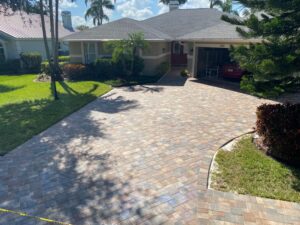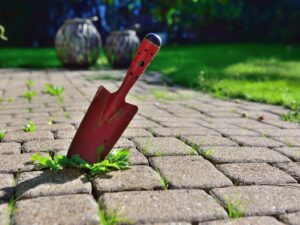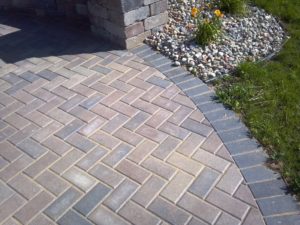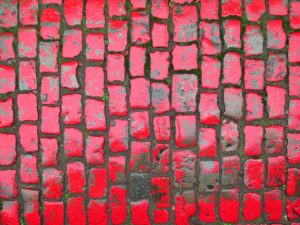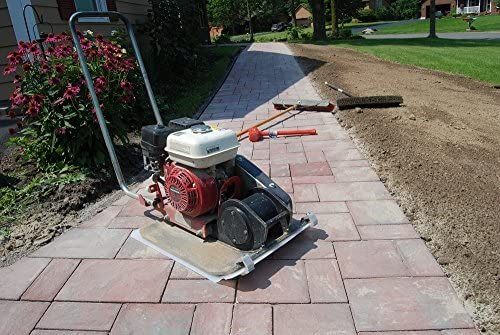
Anyone who has ever worked with pavers knows how intricate the installation process is. At the final stages, for example, compacting the pavers is crucial for the success of an installation. So how to compact pavers with a plate compactor? Is it an easy process?
Unfortunately, this is a step that is often skipped by many people during the installation process of pavers. But compacting the pavers to set them in place before adding polymeric sand is crucial.
Skipping this part can make your installation unleveled – and in the worst cases, it can ultimately cause your pavers to shift and sink.
So let’s give you a rundown on how to properly do that compaction.
How to Compact Pavers With a Plate Compactor?
You’re going to compact your pavers right before setting them in place, and then again before adding the polymeric sand to your installation.
It all starts with choosing the right plate compactor for the job. For a small area, a single plate compactor is more than enough. For bigger installations, a reversible compactor might come in handy.
We don’t recommend the use of heavy-duty compactors from a DIY perspective. Using them without proper training can be dangerous and can easily scratch or even break the pavers.
First of all, it is important to notice that you need to protect your pavers, especially the natural stone ones. A very common practice is attaching a rubber mat to the base of the plate compactor. Some models even come with a special device to do so.
Then you have to mind the “strength” of the plate compactor. You will never need anything above 3,000 pounds to do the job, so make sure the settings are in order.
Go over the installation at least once before applying the polymeric sand. Afterwards, you can spread the polymeric sand on your installation, making sure to sweep the sand around to fill every joint between the pavers.
You’ll have to use the compactor one more time. After that, check if there’s still space to be filled in the joint. In case there is, repeat the process, adding more polymeric sand as you see fit.
Repeat as many times as necessary until the joints are completely filled. To top it all off, sweep the excess sand away and slightly mist your pavers with the help of a garden hose.
After waiting a few days, your installation will be ready to be sealed and finally finished.
Other Ways to Compact Pavers
Plate compactors are the most trustworthy method to compact pavers. If you don’t feel like spending your money on a rental machine, though, you have two other good options.
The first one is simply a hand tamper; it can work well for small worksites, but for big ones maybe it is too much work. They won’t help you too much with compacting the polymeric afterward, and you’ll still have to protect your pavers with a rubber mat somehow.
The other option – in fact, much used by many professionals in the industry – is a rubber mallet. Simply slightly tapping your pavers in place, one by one, as soon as you place them, with a rubber mallet can already do the trick. Once again, it won’t help you compact the sand, but it has the advantage of dispensing the need to protect the pavers.
How does a Plate Compactor Work?
Plate compactors do their job by exerting a certain amount of force on the ground through a large plate of steel. They do that by vibrating rapidly, encouraging granular elements to sync the vibration and move as well.
The strength of this vibration will depend on exactly what kind of plate compactor you’re working with, as we already mentioned.
Most plate compactors work with diesel or gasoline, but there are also some electrical options in the market. Since they vibrate a lot, some options come with a device that isolates the vibration on the steering handles to avoid discomfort while using it.
Professional Help With Plate Compactors
Out of all the many tasks involving a paver installation, compaction is a crucial step to its success.
We here at SS Pavers have seen many installations that were not properly compacted and caused severe problems later on. That’s why we never recommend tackling a paver installation project from a DIY perspective unless you are absolutely sure of what you’re doing and have the right equipment for it.
It is heartbreaking to see so much time and money invested in installations that could have gone great if only some important details were not forgotten along the way.
Over our 12 years of activity, we have seen it happen many times. So don’t hesitate to ask for the help of a professional hardscape contractor in your area! If you happen to be around our area of activity, the Sarasota and Manatee counties, in Florida, why not give us a call to help you out?
You can contact us any time for a free estimate on our services. Call us right now at 941-773-3098 or email us at sales@sspavers.com. We would be more than happy to provide your pavers with expert compaction as well as any other hardscape needs you might have.

